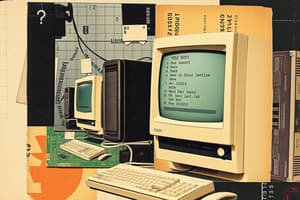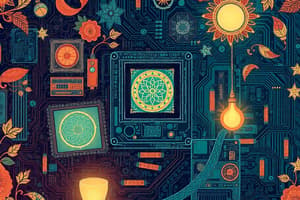Podcast
Questions and Answers
Which characteristic distinguishes digital computers from analog computers?
Which characteristic distinguishes digital computers from analog computers?
- Process discrete data (correct)
- Have limited memory capacity
- Perform calculations manually
- Use continuous data
What is the primary function of the Central Processing Unit (CPU) in a computer?
What is the primary function of the Central Processing Unit (CPU) in a computer?
- Transmitting data over networks
- Displaying output on the monitor
- Processing data and executing commands (correct)
- Storing information permanently
Which component is NOT typically considered part of computer hardware?
Which component is NOT typically considered part of computer hardware?
- Operating System (correct)
- Hard Disk
- Monitor
- Keyboard
In a Windows operating system, what is the purpose of Windows Explorer?
In a Windows operating system, what is the purpose of Windows Explorer?
Which type of device is a mouse categorized as?
Which type of device is a mouse categorized as?
Flashcards
Analog Computer
Analog Computer
A type of computer that uses continuous data representations, typically used for physical measurements and processes.
Digital Computer
Digital Computer
A type of computer that uses discrete data representations. Most modern computers are digital.
Central Processing Unit (CPU)
Central Processing Unit (CPU)
The brain of a computer, responsible for processing data and instructions.
Operating System
Operating System
Signup and view all the flashcards
DOS (Disk Operating System)
DOS (Disk Operating System)
Signup and view all the flashcards
Study Notes
Historical Development of Computers
- Computers evolved from fundamental concepts.
- Computer characteristics, memory, classification, and digital/analog types exist.
- Applications of computers are diverse.
Computer Hardware
- Input devices gather information (e.g., keyboard, mouse).
- Output devices display information (e.g., monitor).
- The Central Processing Unit (CPU) is the brain of the computer, handling processing.
- Hardware components include the motherboard, processor, memory (RAM), hard disk, floppy disk, optical drive, keyboard, mouse, monitor, network interface card (NIC), modem, and others.
Disk Operating System (DOS)
- DOS is an introduction to operating systems.
- DOS commands are used for file management and execution.
- Batch files automate tasks using DOS commands.
- Advanced DOS commands offer more control.
Windows Operating System (Windows)
- Windows is a modern operating system.
- Multitasking allows multiple tasks to run concurrently.
- Users interact with Windows through the graphical user interface.
- File and folder management is through Windows Explorer.
- Software like Notepad, Paint, WordPad facilitate text and image editing.
- Other programs exist for specialized tasks.
Studying That Suits You
Use AI to generate personalized quizzes and flashcards to suit your learning preferences.




